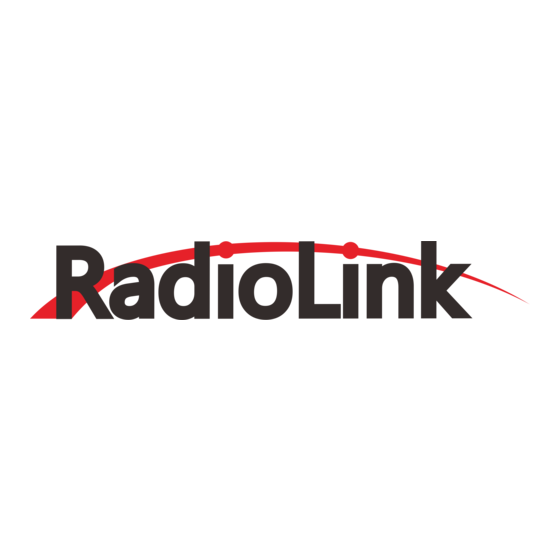
Advertisement
Quick Links
Advertisement

Subscribe to Our Youtube Channel
Summary of Contents for RadioLink RTC8
- Page 1 RTC8 SBUS/PPM to CAN Protocol Encoder...
-
Page 2: Table Of Contents
Contents Chapter 1. Overview ...................2 Chapter 2. Specifications ................3 Chapter 3. Main Functions ................. 3 Chapter 4. Driver installation ..............4 Chapter 5. Firmware update ..............5 Chapter 6. SBUS/PPM to CAN Explorer ........... 6... -
Page 3: Chapter 1. Overview
Chapter 1. Overview 1. CAN receive/send interface: Used to send and receive CAN data. Working baud rate range is 5Kbit/s ~1Mbit/s. 2. Termination resistor 120Ω The short-circuit jumper cap can absorb signal reflection and echo. 3. Firmware update button Press and hold the button, then connect the encoder to the computer via USB to enter the firmware update mode. -
Page 4: Chapter 2. Specifications
Chapter 2. Specifications 1. The PC interface conforms to the specification of USB2.0 full-speed interface and is compatible with USB1.1 and USB3.0. 2. Integrate 1 CAN-BUS interface, and use plug-in terminal wiring method 3. Conform to IOS/DIS 11898 specification 4. CAN-BUS communication baud rate can be freely programmed between 5Kbps~1Mbps 5. -
Page 5: Chapter 4. Driver Installation
Chapter 4. Driver installation 1. Use a USB cable to connect the SBUS/PPM to CAN Protocol encoder to the computer. 2. After the successful connection, there will be a new COM port in computer device manager. -
Page 6: Chapter 5. Firmware Update
Chapter 5. Firmware update 1. Press and hold the firmware update button(do not supply power to the encoder). Then connect the encoder to the computer via USB, the blue light will start to flash. Release the firmware update button. 2. The computer pops up a window asking whether the U disk needs to be formatted, and you can directly close the window. -
Page 7: Chapter 6. Sbus/Ppm To Can Explorer
Chapter 6. SBUS/PPM to CAN Explorer 1. Status information display (1) CAN: Display currently received CAN data (after filtering ID). (2) SBUS: If there is an SBUS signal input, the SBUS channel data will be displayed. (3) PPM: If there is a PPM signal input, the PPM channel data will be displayed. - Page 8 2. Debug/Status information 3. Parameter configuration Notice! ① Each time the device is connected, the parameters will be automatically obtained once and sent to the computer. ②All parameters must be written after modification. Click "Optimset" in the lower right corner, otherwise the parameters will not be set successfully.
- Page 9 Note: ① The synchronization segment is always 1. ② PTS and BS1 have been merged, so the width of BS1 is equal to the width of PTS+BS1. ③ Sample: Automatically calculate sampling points according to BS1 and BS2. Configuration references: https://blog.csdn.net/piaolingyekong/article/details/124276670 (2) CAN Acceptance Filter ①Running Mode...
- Page 10 Note: It is prohibited that all 7 bits are recessive. (Prohibited setting: ID=1111111XXXX) ③Default Values (1) Click and all parameters on this page will be restored. ④Preset ID (1) The ID that receives the channel data (Refer to Preinstall). ⑤User Filter ID setting If you only want to receive the standard frame whose CAN ID is 0x317, the setting method is as follows: Filter ID: Set to the binary bit 011 0001 0111, corresponding to 317.
- Page 11 (4) ID2: ID that sending data of channel 5-8 (5) ID3: ID that sending data of channel 9-12 (6) ID4: ID that sending data of channel 13-16 (7) Cycle Time: The cycle of actively sending channel data (8) Active Mode: Active sending mode. When Active Mode is ticked, there is no need to send the command to obtain data to the SBUS/PPM to CAN Protocol encoder, and the device will periodically send channel data to the CAN bus at the time set by Cycle Time.
Need help?
Do you have a question about the RTC8 and is the answer not in the manual?
Questions and answers